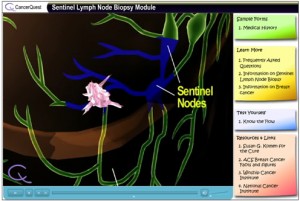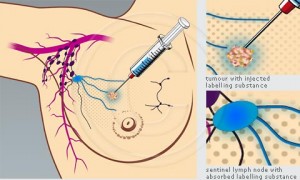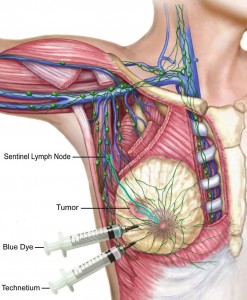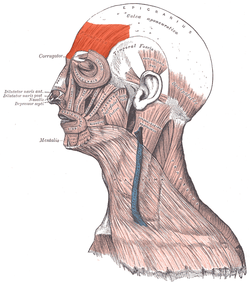Sentinel Lymph Node Definition
Page Contents
- 1 Sentinel Lymph Node Definition
- 2 Sentinel Lymph Node Location
- 3 Sentinel Lymph Node Anatomy
- 4 Sentinel Lymph Node Mapping
- 5 Sentinel Lymph Node Injection
- 6 Sentinel Lymph Node Surgery
- 7 Sentinel Lymph Node Melanoma
- 8 Lumpectomy Sentinel Lymph Node Biopsy
- 9 Sentinel Lymph Node Ultrasound
- 10 Sentinel Lymph Node Removal
- 11 Sentinel Lymph Node Recovery
The Sentinel Lymph Node is the hypothetical lymph node or lymph nodes that is the closest to the primary lesion, and is the first one to receive direct drainage from the injection site. It is the first lymph node that is reached by the metastasizing cancer cells. If this node is found free of cancer cells, then there is comparatively less chances of other nodes being full of malignant cancer cells and thereby the need for surgical removal of tumor and other complications is removed.

Picture 1 – Sentinel Lymph Node
Source – cancerquest.org
Sentinel Lymph Node Location
The sentinel lymph node is located along the lymphatic vessels, as a part of the lymphatic system, which is the body’s primary immune system.
Sentinel Lymph Node Anatomy
It is the First lymph node that the cancer cells from a primary tumor reach. These cancer cells follow a very orderly progression to reach theses nodes. They first spread to the regional lymph nodes, and then to the echelon of these nodes. We can therefore say that the lymph flow is directional. The cancer cells first spread to these lymph nodes, before they reach other parts of the body. So, cancer also first spreads to lymph nodes, and then to the other parts of the body. If the sentinel node is free of cancer cells, then there is a high probability that it will not spread to other parts of the body as well.
Sentinel Lymph Node Mapping
Sentinel Lymph Node Mapping is a method that determines whether the cancer has spread beyond the tumor, deep into the lymph system. This procedure is used in addition to that of sentinel lymph node biopsy and dissection. Since the lymph node is the primary defense against infection in the body, it is very important that the cancer cells do not permanently stay in this system. When the cells reach this system, biopsy or dissection is performed.
Sentinel Lymph Node Injection
 Picture 2 – Sentinel Lymph Node Injection
Picture 2 – Sentinel Lymph Node Injection
Source – pathologle-vechtade.
Before starting a Sentinel lymph Node biopsy technique, it is very essential to perform the sentinel lymph node injection procedure. This means it is necessary to inject a small dose of all low-level of radioactive tracer, known as technetium-99 in the breast region of the patient.
Sentinel Lymph Node Surgery
Sentinel node surgery is basically a process of that is used in the staging of certain types of cancer, and to analyze whether cancer has spread to the lymph nodes. This surgery includes a method called Sentinel Lymph Node Biopsy or Sentinel Node procedure. Sometimes a frozen section procedure is also used, if neoplasia is also detected in the lymph node.
Sentinel Lymph Node Melanoma
Melanoma is a kind of lethal disease, the incidence of which continues to increase with time, instead of decreasing. Its incidence increases faster than any other kind of cancer. When the lymph nodes metastasize, the regional lymph nodes are the first one to detect the site of their spread. There are certain risk factors associated with melanoma, such as multiple clinically atypical moles, dysplastic nevi, sun exposure and inherited genetic mutations.
Sentinel Lymph Node Biopsy Melanoma
Melanoma does not have a fixed direction. It is generally not possible to find out the direction of travel of melanoma. Therefore, the general destination of melanoma is found out by using a technique called Lymphoscintigraphy. This technique involves injecting a small amount of a radioactive substance in and around the site of melanoma. Melanoma Sentinel Lymph Node biopsy is also used to treat this disease. This biopsy determines the amount of melanoma cell colonies that the lymph node receives. If the sentinel node does not reveal the occurrence of melanoma, then there is a high probability that the person does not have melanoma at all.
Lumpectomy Sentinel Lymph Node Biopsy
Lumpectomy is a procedure that may be performed by using a local anesthetic, sedation or any general form of anesthesia, which usually depends on the extent to which surgery is required. In this process, the surgeon makes a very small incision over the breast tumor, and cuts a lump of the abnormal growing margin around the breast tissue. After lumpectomy is performed, there is no further need of the Sentinel lymph Node.
Lumpectomy may have the following side effects:
- It may cause temporary swelling of the breast
- It causes breast tenderness
- It may cause breast hardness because of the formation of a scar tissue at the surgical site.
Lumpectomy is often followed by a radiation therapy so that the cancer cells that may have survived also destroyed to prevent any further chances of reoccurrence of cancer. Radiation treatment begins a week after lumpectomy.
Sentinel Lymph Node Biopsy Procedure
Sentinel Lymph Node Biopsy is a procedure of removing the sentinel lymph node, which is then examined under a microscope so as to examine whether cancer cells are present. It is also called Sentinel Node biopsy or Sentinel Node Dissection because the lymph node is dissected so that it can be examined for the presence of malignant cancer cells. It is a surgical process, and is often associated with breast cancer treatment or used for staging Malignant Melanoma. This process is in use for as long as ten years.
Sentinel Lymph Node Biopsy Breast Cancer
Breast cancer is often diagnosed with the biopsy of the Sentinel Lymph Node. There was a traditional method called axiliary lymph node dissection, this involved removal of the node that lied in the armpit region. But sentinel lymph node biopsy technique is being increasingly used for the treatment of breast cancer.
This procedure is less time consuming, and involves less pain since incision made is comparatively very small. The time required for recovery is also very less. The main advantage of this technique is that it does not unnecessarily involve removal of sentinel node if cancer has not spread to this region.
Sentinel Lymph Node Biopsy Health
For the performance of sentinel node biopsy, there are certain conditions that should be fulfilled by women. Not all women can go for a sentinel node biopsy. A woman who has the following is a poor candidate for this procedure:
- Her lymph nodes are palpable and hard
- Absolute contradictions:
o Cancer identified in the lymph nodes
o Masectomy
- Poor general heath or long term illness
- Smoking
- Obese women
- Usage of certain dietary supplements.
 Picture 3– Sentinel Lymph Node Biopsy
Picture 3– Sentinel Lymph Node Biopsy
Source – gammaprobe.com
Sentinel Lymph Node Ultrasound
Sometimes, the technique of ultrasound is used to image the ex-ivivo methylene blue dyes sentinel node that is embedded in our breast tissue. It is performed using a ring shaped light illumination and intense acoustic burst, camera based speckle and a charged couple device. It is a good imaging modality which detects sentinel lymph nodes in the staging of breast cancer.
Sentinel Lymph Node Removal
Sometimes, the surgeon may prescribe for the removal of lymph node, if the cancer has spread and has increased in size beyond a certain limit. This may be at the same time as that of removal of primary tumor.
Sentinel Lymph Node Recovery
It takes some time for the patient to recover from the surgical removal of lymph node. If the pain is minimal, pain killers such as paracetamol or ibuprofen will help. The patient must avoid alcohol or some time. The patient should always keep the affected area mobile, so that it does not get stiff. It should also be made sure that the patient is not into any sort of strenuous activity, for at least a few months after the surgery.
The Sentinel Lymph Node is the first lymph node that receives the malignant cancer cells from a primary tumor. Therefore any sort of treatment that is done to it should be performed carefully and with under proper medical supervision.
References:
http://en.wikipedia.org/wiki/Sentinel_lymph_node
http://www.caring4cancer.com/go/cancer/diagnosis/biopsy.htm
http://www.cancernews.com/data/Article/202.asp
http://www.breastcancer.org/treatment/surgery/lymph_node_removal/sentinel_dissection/
http://emedicine.medscape.com/article/854424-overview
http://www.medicinenet.com/sentinel_lymph_node_biopsy/article.htm
http://www.cancer.gov/cancertopics/factsheet/Therapy/sentinel-node-biopsy

